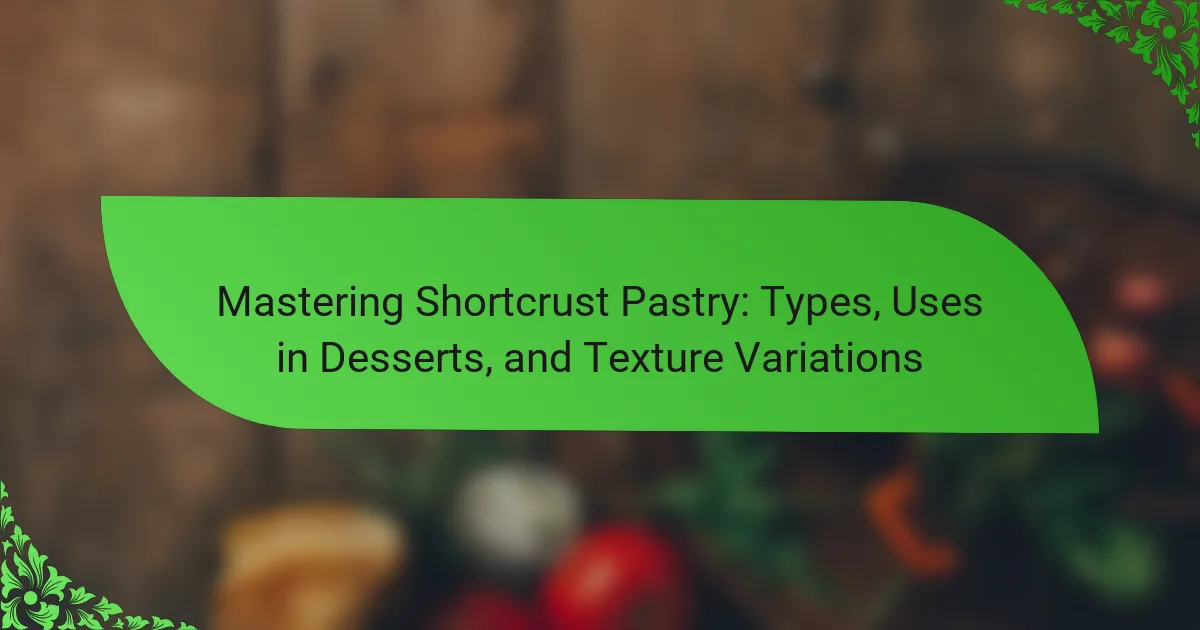Shortcrust pastry is a versatile type of pastry characterized by its crumbly texture, primarily made from flour, fat—usually butter—and water. This pastry serves as a foundational element for both sweet and savory dishes, including pies, tarts, and quiches. The article covers the essential techniques for achieving the perfect texture, emphasizing the importance of using cold ingredients and proper resting time for the dough. Additionally, it explores various applications of shortcrust pastry in dessert preparation, highlighting its ability to complement diverse fillings and its role in creating layered desserts and cookies.

What is Shortcrust Pastry?
Shortcrust pastry is a type of pastry known for its crumbly texture. It is made from flour, fat, and water. The fat is typically butter, which contributes to its rich flavor. Shortcrust pastry is often used as a base for pies and tarts. It can be sweet or savory, depending on the recipe. The dough is rolled out and placed in a baking dish. It is then blind-baked or filled before baking. Shortcrust pastry is favored for its ability to hold shape and provide a flaky crust.
How is Shortcrust Pastry made?
Shortcrust pastry is made by combining flour, fat, and water. First, sift the flour into a bowl. Then, cut cold butter into small cubes. Mix the butter into the flour using your fingertips until it resembles breadcrumbs. Next, add cold water gradually, mixing until the dough comes together. Avoid overworking the dough to keep it tender. Wrap the dough in plastic wrap and refrigerate for at least 30 minutes. Chilling helps relax the gluten, resulting in a flaky texture. Roll out the chilled dough on a floured surface to the desired thickness before using it in recipes.
What ingredients are essential for Shortcrust Pastry?
Flour, fat, and water are essential ingredients for shortcrust pastry. Typically, all-purpose flour is used for its balance of structure and tenderness. Unsalted butter is the most common fat, providing flavor and a flaky texture. Cold water is added to bind the ingredients without developing gluten. Salt is often included to enhance flavor. These ingredients create a versatile pastry suitable for both sweet and savory dishes.
What techniques are used in the preparation of Shortcrust Pastry?
Shortcrust pastry is prepared using several key techniques. The first technique is the rubbing-in method, where cold fat is mixed with flour until it resembles breadcrumbs. This technique ensures a flaky texture. The second technique is to add cold water gradually to form a dough. This helps bind the ingredients without overworking the mixture. Chilling the dough is another important technique. It allows the gluten to relax, preventing shrinkage during baking. Rolling out the dough evenly is crucial for uniform thickness. Finally, blind baking is often employed to prevent sogginess in the final pastry. Each of these techniques contributes to the overall quality and texture of shortcrust pastry.
What are the different types of Shortcrust Pastry?
There are several types of shortcrust pastry. The most common types include sweet shortcrust pastry, savory shortcrust pastry, and wholemeal shortcrust pastry.
Sweet shortcrust pastry is often used for desserts. It contains sugar, which adds sweetness. This type is ideal for tarts and pies. Savory shortcrust pastry lacks sugar and is used for quiches and savory pies. Wholemeal shortcrust pastry incorporates whole wheat flour. This variation offers a nuttier flavor and is often considered healthier.
Each type of shortcrust pastry serves different culinary purposes. Their unique compositions cater to specific flavor profiles and textures.
What distinguishes Sweet Shortcrust Pastry from Savory Shortcrust Pastry?
Sweet Shortcrust Pastry is characterized by the inclusion of sugar, while Savory Shortcrust Pastry typically does not contain sugar. The sweetness in Sweet Shortcrust Pastry enhances dessert flavors. In contrast, Savory Shortcrust Pastry complements savory fillings, such as meats or vegetables. Sweet Shortcrust Pastry often utilizes butter for a rich flavor. Savory versions may use lard or margarine for a different texture. The texture of Sweet Shortcrust Pastry is usually more tender and crumbly. Savory Shortcrust Pastry tends to be firmer and sturdier to hold heavier fillings. These distinctions highlight their different culinary uses and flavor profiles.
How does the texture vary between different types of Shortcrust Pastry?
The texture of shortcrust pastry varies significantly based on its preparation method and ingredients. Traditional shortcrust pastry has a crumbly and tender texture. This is achieved by using a higher fat-to-flour ratio. In contrast, sweet shortcrust pastry includes sugar, resulting in a slightly more crumbly and sweet texture.
Richer versions, such as pâte sucrée, incorporate egg yolks, leading to a smoother and more pliable texture. Conversely, a savory shortcrust pastry may have a firmer texture due to the absence of sugar and the use of salt.
Each type of shortcrust pastry can also vary based on the type of fat used. Butter gives a rich flavor and a flaky texture, while shortening can create a more tender, biscuit-like texture. The method of mixing also impacts texture; overworking the dough can lead to a tougher pastry.
These variations illustrate how ingredient choices and preparation techniques influence the final texture of shortcrust pastry.

What are the primary uses of Shortcrust Pastry in desserts?
Shortcrust pastry is primarily used for creating pie and tart bases in desserts. It provides a flaky and tender texture that complements sweet fillings. Common desserts made with shortcrust pastry include fruit tarts, custard pies, and quiches. The pastry can be sweetened or left plain, depending on the dessert. It is versatile and can be used for both baked and unbaked desserts. Additionally, shortcrust pastry serves as a base for layered desserts and can be shaped into cookies. Its ability to hold various fillings makes it a staple in dessert preparation.
What types of desserts commonly use Shortcrust Pastry?
Shortcrust pastry is commonly used in various desserts. This includes tarts, pies, and quiches. Fruit tarts often feature a layer of shortcrust pastry filled with fresh fruits. Custard tarts utilize shortcrust pastry to hold a rich custard filling. Lemon meringue pie is another dessert that relies on shortcrust pastry for its base. Additionally, sweet pies, such as apple or cherry pie, are made with shortcrust pastry. These desserts benefit from the crisp and buttery texture of the pastry.
How is Shortcrust Pastry utilized in tarts and pies?
Shortcrust pastry is utilized as a base for tarts and pies. It provides a firm and flaky texture that supports various fillings. The dough is made from flour, fat, and water, which creates a rich flavor. After mixing, the pastry is chilled to enhance its texture. It is then rolled out and placed in tart or pie pans. The edges are often crimped for aesthetic appeal. Shortcrust pastry can be blind-baked before adding fillings. This prevents sogginess and ensures a crisp finish. Its versatility allows for both sweet and savory applications in desserts.
What role does Shortcrust Pastry play in layered desserts?
Shortcrust pastry serves as a foundational layer in layered desserts. It provides a crisp and flaky texture that contrasts with softer components. This pastry acts as a structural base, supporting various fillings. Its neutral flavor complements sweet or savory layers. Shortcrust pastry can absorb moisture without becoming soggy. This quality helps maintain the integrity of the dessert over time. Additionally, it can be pre-baked to enhance its crispness. The use of shortcrust pastry elevates the overall presentation and enjoyment of layered desserts.
Why is Shortcrust Pastry preferred in certain dessert recipes?
Shortcrust pastry is preferred in certain dessert recipes due to its tender and crumbly texture. This texture enhances the overall mouthfeel of desserts. The high fat content in shortcrust pastry contributes to its flakiness. It creates a rich, buttery flavor that complements sweet fillings. Shortcrust pastry also holds its shape well during baking. This characteristic is essential for tarts and pies. Additionally, it can be easily molded into various shapes. These attributes make it versatile for both sweet and savory applications.
What texture benefits does Shortcrust Pastry provide in desserts?
Shortcrust pastry provides a delicate, crumbly texture in desserts. This texture enhances the overall mouthfeel of various sweet dishes. The pastry’s structure allows for a balance between crispness and tenderness. It creates a pleasant contrast with fillings, such as fruit or custard. Shortcrust pastry also holds its shape well during baking. This stability prevents sogginess and maintains texture integrity. The fat content in the pastry contributes to its flaky quality. This flakiness adds a layer of richness to the dessert experience.
How does Shortcrust Pastry enhance the flavor profile of desserts?
Shortcrust pastry enhances the flavor profile of desserts by providing a rich, buttery base. This pastry is made with flour, fat, and water, creating a tender texture. The fat used, typically butter, contributes a creamy flavor that complements sweet fillings. Its crumbly texture contrasts with smooth fillings, adding depth to each bite. Additionally, shortcrust pastry can absorb flavors from the filling, enriching the overall taste experience. This pastry serves as a versatile foundation for both sweet and savory desserts, making it a popular choice in various recipes. Its ability to hold shape while baking ensures a consistent texture, further enhancing the dessert’s appeal.

How can one achieve the perfect texture with Shortcrust Pastry?
To achieve the perfect texture with shortcrust pastry, use cold ingredients. Cold butter helps create a flaky texture. The butter should be cubed and kept chilled before mixing. Next, combine flour and salt in a bowl. Use a pastry cutter or fingers to mix until the mixture resembles coarse crumbs. Avoid overworking the dough to maintain flakiness. Add ice-cold water gradually until the dough holds together. Chill the dough for at least 30 minutes before rolling it out. This resting period allows gluten to relax, resulting in a tender pastry. Proper baking temperature also contributes to texture. Bake at a high temperature for a crisp finish.
What factors influence the texture of Shortcrust Pastry?
The texture of shortcrust pastry is influenced by several key factors. The ratio of fat to flour is crucial; higher fat content results in a more tender texture. The type of fat used, such as butter or shortening, also affects the final texture. Butter provides a rich flavor and flakiness, while shortening can yield a more tender crust.
The method of mixing is significant; overmixing can develop gluten, leading to a tougher texture. Conversely, minimal mixing helps maintain a delicate structure. The temperature of the ingredients matters as well; using cold fat and water helps create a flaky texture.
Chilling the dough before baking allows the fat to solidify, which contributes to a better texture. The baking temperature and time can also influence texture; higher temperatures create a crisp outer layer. Each of these factors plays a vital role in achieving the desired texture of shortcrust pastry.
How does the ratio of fat to flour affect the texture?
The ratio of fat to flour significantly influences the texture of shortcrust pastry. A higher fat content results in a tender and crumbly texture. This is because fat coats the flour particles, inhibiting gluten formation. Lower fat content leads to a firmer texture, as more gluten develops during mixing. For instance, a typical ratio is 1:2 (fat to flour) for a flaky pastry. This ratio allows for a balance between tenderness and structure. Research indicates that optimal fat levels improve the overall mouthfeel and crumb structure of baked goods.
What impact does chilling the dough have on texture?
Chilling the dough significantly impacts its texture. It helps to firm up the fat within the dough. This results in a more tender and flaky pastry. Chilling allows gluten to relax, reducing toughness. Additionally, it helps to prevent shrinkage during baking. The dough becomes easier to handle and roll out. Cold dough maintains its shape better when baked. Overall, chilling enhances the final texture of the pastry.
What common mistakes should be avoided when making Shortcrust Pastry?
Overworking the dough is a common mistake when making shortcrust pastry. This can lead to a tough texture rather than a tender one. Using cold ingredients is essential. Warm butter can cause the pastry to spread too much during baking. Not chilling the dough before rolling out is another error. Chilling helps maintain the structure and prevents shrinkage. Additionally, using the wrong flour can affect the outcome. All-purpose flour is typically preferred for the right balance of texture. Skipping the resting time after mixing can also be detrimental. Allowing the dough to rest improves the final texture. Lastly, not properly measuring ingredients can lead to inconsistencies. Accurate measurements are crucial for achieving the desired result.
How can overworking the dough affect the final texture?
Overworking the dough leads to a tough and dense texture. This occurs because excessive kneading develops gluten. Gluten is a protein that provides structure but can make the pastry chewy when overdeveloped. A well-balanced dough should be tender and flaky. Shortcrust pastry relies on minimal gluten formation for the desired texture. When the dough is overworked, it loses its lightness and becomes less pleasant to eat. Studies show that optimal mixing time is crucial for achieving the right texture in baked goods.
What are the signs of underbaking Shortcrust Pastry?
Signs of underbaking Shortcrust Pastry include a pale color and a soft, doughy texture. The edges may appear slightly raw or not fully set. The bottom may remain too soft and lack a crisp finish. Additionally, the pastry may shrink away from the edges of the pan. When cut, it may crumble excessively rather than hold its shape. These characteristics indicate that the pastry has not been baked long enough to develop the desired texture and flavor. Proper baking typically results in a golden-brown color and a firm, flaky texture.
What tips can help in mastering Shortcrust Pastry?
To master shortcrust pastry, ensure your ingredients are cold. Cold butter and water help create a flaky texture. Use a food processor for even mixing. This prevents overworking the dough. Add a pinch of salt for flavor enhancement. Chill the dough before rolling it out. This helps maintain its shape during baking. Roll the dough evenly to avoid thick spots. Finally, blind bake for a crisp base when needed. These techniques consistently yield successful results.
Shortcrust pastry is a versatile pastry known for its crumbly texture, made from flour, fat, and water, commonly used as a base for both sweet and savory dishes. This article explores the various types of shortcrust pastry, including sweet, savory, and wholemeal variations, and their specific uses in desserts such as tarts and pies. It also details essential ingredients, preparation techniques, and factors influencing texture, including fat-to-flour ratios and the importance of chilling the dough. Additionally, the article provides tips for mastering shortcrust pastry and highlights common mistakes to avoid for achieving optimal results.
